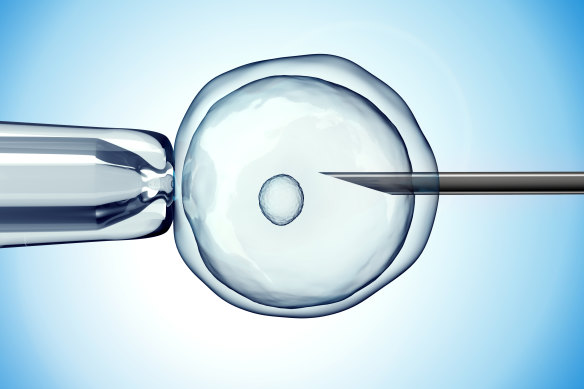A record one in 18 babies born in Australia is now conceived via IVF, but the chance of success is heavily dependent on a woman’s age and the clinic she chooses.
More than one in seven IVF cycles undertaken in 2020 were single or in a same-sex couple, the analysis of the Australian and New Zealand Assisted Reproductive Database shows.

One in 18 babies born in Australia are conceived via IVF. Credit: Istock
And as IVF success rates continue to rise, they’re still heavily dependent on a woman’s age and the clinic she chooses.
The report also revealed alarming variations in the success rates of individual clinics, ranging from over 35 per cent for the top-performing clinics to roughly 7 per cent.
And despite the steep drop-off in the chances of having a baby for women in their forties, almost one-quarter of IVF patients were over 40.
There were 16,439 live-born IVF babies in 2020, one in 18 of the 295,976 babies born in Australia that year, and about 1300 more IVF babies than in 2019.
That same year, Australian IVF clinics recorded 87,206 cycles, the report compiled by researchers at UNSW’s National Perinatal Epidemiology and Statistics Unit showed.
Professor Luk Rombauts, President of the Fertility Society of Australia and New Zealand, said the data was “evermore reassuring of the positive trend in IVF year-on-year”.
The overall success rate per initiated IVF cycle was 23.1 per cent, up from 19.5 per cent in 2013.
More than one in ten women who underwent IVF in 2020 were single (10.2 per cent), and 3.9 per cent were in same-sex relationships.
“It’s great to be able to offer them the opportunity to start their own non-traditional families,” Rombauts said.
The report’s lead author, Professor Georgina Chambers said the increase in success rates was driven by frozen cycles, where an embryo is frozen and thawed before being transferred back into the woman. Almost two thirds (65 per cent) of IVF babies are now being born using frozen embryos.
The success rate per initiated frozen cycle rose from 21.8 per cent in 2013 to 30.7 per cent in 2020, while the success rate per fresh cycle was stable (16.2 per cent in 2020), Chambers said.
But the older the woman, the slimmer chance of having a baby using her own eggs, she said.
Dr Karin Hammarberg, a fertility expert at Monash University and Your Fertility (an online educational resource) said “I don’t think it’s well understood just how dramatically the success rate decreases after 40. IVF becomes a very difficult journey”.
Individual IVF clinics were de-identified in the report, so it is impossible to know which are responsible for the below-average success rates.
Hammarberg said the patient mix at each clinic would affect results. For instance, clinics that catered to young and healthy patients would yield better success rates than clinics that had an older patient population with complex fertility problems.
“But the huge difference in success rates between clinics - from 35 per cent and 7 per cent - is quite difficult to explain in these terms,” Hammarberg said.
“I do think there are differences in the quality of their labs and doctors between these clinics,” she said.
Rombauts said the FSANZ’s accreditation arm sends letters of warning to clinics that were underperforming and offered advice and support to “lift their game”.
“We have the option - a very blunt instrument - to withdraw accreditation, but that’s something that isn’t easy to do,” Rombauts said. “Ultimately, it’s really for couples and individuals to do their homework,” he said.
He strongly urged them to use the Your IVF Success website, which draws on ANZARD data to help women understand their own chances of having a baby via IVF, and compares the success rates of IVF clinics located near them.
Clinics must agree to the publication of their success rates, and several have chosen to withhold this information from the public.
The proportion of twins and triplets born through IVF dropped to a new low. Just 2.8 per cent of all IVF births in Australia and New Zealand in 2020, down from 7.9 per cent in 2010.
When it came to women choosing to freeze their eggs, more than one in three egg-freezing cycles were for non-medical reasons (women didn’t have a partner, or weren’t ready to have a baby for career or other reasons).
The Morning Edition newsletter is our guide to the day’s most important and interesting stories, analysis and insights. Sign up here.